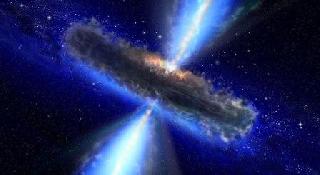
This artist's concept illustrates a quasar, or feeding black hole, similar to APM 08279+5255, where astronomers discovered huge amounts of water vapour. Photo by NASA/ESA.
PASADENA (BNS): Two teams of astronomers have discovered the largest and farthest reservoir of water ever detected in the universe.
The water, equivalent to 140 trillion times all the water in the world's ocean, surrounds a huge, feeding black hole, called a quasar, more than 12 billion light-years away.
"The environment around this quasar is very unique in that it's producing this huge mass of water," said Matt Bradford, a scientist at NASA's Jet Propulsion Laboratory, who leads one of the teams that made the discovery.
"It's another demonstration that water is pervasive throughout the universe, even at the very earliest times."
A quasar is powered by an enormous black hole that steadily consumes a surrounding disk of gas and dust. As it eats, the quasar spews out huge amounts of energy.
Both groups of astronomers studied a particular quasar called APM 08279+5255, which harbours a black hole 20 billion times more massive than the sun and produces as much energy as a thousand trillion suns.
Astronomers expected water vapour to be present even in the early, distant universe, but had not detected it this far away before. There's water vapour in the Milky Way, although the total amount is 4,000 times less than in the quasar, because most of the Milky Way's water is frozen in ice.
Water vapour is an important trace gas that reveals the nature of the quasar. In this particular quasar, the water vapour is distributed around the black hole in a gaseous region spanning hundreds of light-years in size (a light-year is about six trillion miles).
Its presence indicates that the quasar is bathing the gas in X-rays and infrared radiation, and that the gas is unusually warm and dense by astronomical standards.
Although the gas is at a chilly minus 63 degrees Fahrenheit (minus 53 degrees Celsius) and is 300 trillion times less dense than Earth's atmosphere, it's still five times hotter and 10 to 100 times denser than what's typical in galaxies like the Milky Way, a NASA JPL release said.
Bradford's team made their observations starting in 2008, using an instrument called "Z-Spec" at the California Institute of Technology's Submillimeter Observatory, a 33-foot (10-meter) telescope near the summit of Mauna Kea in Hawaii.
The second group, led by Dariusz Lis, senior research associate in physics at Caltech and deputy director of the Caltech Submillimeter Observatory, used the Plateau de Bure Interferometer in the French Alps to find water.
In 2010, Lis's team detected water in APM 8279+5255, observing one spectral signature. Bradford's team was able to get more information about the water, including its enormous mass, because they detected several spectral signatures of the water, it said.
 Previous Article
Previous Article













The Indian Air Force, in its flight trials evaluation report submitted before the Defence Ministry l..
view articleAn insight into the Medium Multi-Role Combat Aircraft competition...
view articleSky enthusiasts can now spot the International Space Station (ISS) commanded by Indian-American astr..
view article